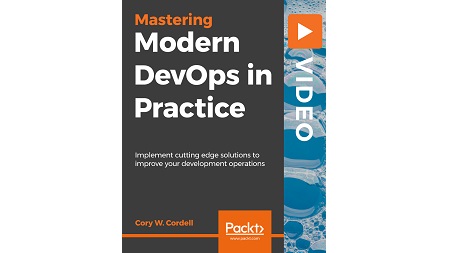
English | MP4 | AVC 1280×720 | AAC 44KHz 2ch | 4h 20m | 665 MB
Automate your infrastructure and overcome day-to-day IT infrastructure challenges
If you’re facing issue of decreased frequency of deployment, high new releases failure rate and longer lead time between fixes than modern DevOps is the answer for your problems. DevOps looks at software development in a whole new way. Let’s take advantage of DevOps to overcome day-to-day IT infrastructure challenges in a more efficient and effective manner.
Modern DevOps in Practice will introduce you to modern Development Operations (DevOps), how to utilize it in your development environment work with tools (Terraform and Azure DevOps). After this course you’ll be able to bring more automation and standardization to the development process, human errors can be significantly reduced and it will be best practices more efficiently shared across teams. Continuous delivery will help you save time setting up and fixing your working environments. Additionally you will learn about the fundamental principles of DevOps and how to transform your team into one that follows the core of DevOps.
By the end of this course you will feel comfortable with what DevOps learn how to utilize modern day tools to better ship code and provide high availability environments.
This course contains examples and demonstrations and will walk you through everything you need to know step by step, by providing you with helpful tips along the way. At the end of the modules, there will be quizzes to help reinforce the topics that you learned from the module.
What You Will Learn
- DevOps concepts, design patterns, developing strategy, and methodologies.
- Explore popular tools available for continuous integration, delivery and deployment.
- Use terraform to automate your infrastructure.
- Containerization using Docker.
- Container orchestration using AKS (Kubernetes).
- Kubernetes and KubeCtl basics.
- Create build configurations to address automation, continuous deployment, containers, and monitoring.
- Integrate a Dockerized app with DevOps style automated workflows.
- Scripting using Bash and Powershell
- Custom tools and helpers using GoLang.
- Additional infrastructure and services (vault, container registry, git) to support the pipeline.
- Build a Continuous Integration and Continuous Deployment Pipeline using Azure DevOps.
- Kubernetes, application, and VM monitoring and logging.
Table of Contents
01 The Course Overview
02 Tools and Setup
03 What Is DevOps
04 History
05 Context
06 People
07 Philosophy
08 Overview
09 Providers
10 Azure
11 Azure Fundamentals
12 Azure Resources
13 Create a Virtual Machine
14 Azure Permissions and Key Vault
15 Azure Portal Alternates
16 Azure REST API
17 Azure REST API and Postman
18 Azure CLI – Part One
19 Azure CLI – Part Two
20 Overview
21 Container Orchestration Tools
22 Docker – Part One
23 Docker – Part Two
24 Docker – Part Three
25 Kubernetes – Part One
26 Kubernetes – Part Two
27 Overview – Infrastructure as Code
28 Languages and Applications
29 Terraform Installation
30 Terraform Provider
31 Terraform Variables
32 Create Resource Group
33 Create Key Vault
34 Overview of Pipeline
35 Pipeline Orchestration Tools
36 Azure DevOps – Part One
37 Azure DevOps – Part Two
38 Console versus YAML Configuration
39 Overview
40 Tools
41 Overview – Scripting Automation and Custom Tools
42 Scripting – Part 1
43 Scripting – Part 2
44 Custom Tools
45 Overview – Course Project
46 Azure DevOps Project Creation
47 Setup the Teams and Planning Boards
48 Setup Repositories
49 Set Branch Policies and Defaults
50 Create Azure Resources – Part One
51 Create Azure Resources – Part Two
52 Create Azure Resources – Part Three
53 Secrets and Variables
54 CI Build Definitions
55 CD Release Definitions – Part 1
56 CD Release Definitions – Part 2
57 CD Release Definitions – Part 3
58 Monitoring
Resolve the captcha to access the links!